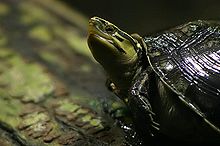Asian box turtle
| Asian box turtle | |
|---|---|
 |
|
| Amboina box turtle, Cuora amboinensis | |
| Scientific classification | |
| Kingdom: | Animalia |
| Phylum: | Chordata |
| Class: | Reptilia |
| Order: | Testudines |
| Family: | Geoemydidae |
| Subfamily: | Geoemydinae |
| Genus: |
Cuora Gray, 1856 |
| Species | |
|
about 12 |
|
| Synonyms | |
|
|
about 12
Asian box turtles are turtles of the genus Cuora in the family Geoemydidae. There are about 12 species. The keeled box turtle (Pyxidea mouhotii syn. Cuora mouhotii) is often included in this genus, or separated in the monotypic genus Pyxidea. Genus Cuora is distributed from China to Indonesia and the Philippines, throughout mainland south-east Asia and into nothern India and even Buthan.
Cuora species are characterized by a low (e.g. Cuora pani) to high (e.g. Cuora picturata) domed shell, which usually has three keels on the carapace. They are reddish, yellowish, brown, grey, and/or black in color. Some species have bright yellow, black, orange, or white stripes down the length of their keels. Their body color is highly variable, but usually very intense. Most species show stripes of variable color down either side of their heads, which usually meet at the nose.
Asian box turtles are terrestrial, semiaquatic or mainly aquatic, most spending much of their time on the edge of shallow swamps, streams or pond that are dense with vegetation. Most are omnivorous, but carnivores do occur.
Listed alphabetically by binomial name.Cuora]. The Reptile Database
Cuora serrata, originally described as C. galbinifrons serrata by Iverson & Mccord and later considered a distinct species are hybrids of the keeled box turtle and taxa of the Indochinese box turtle complex as shown by the genetic studies of Parham et al. and Stuart & Parham (2004). A single specimen of C. serrata has been found in the wild, lending credence to the possibility that other specimens arose through natural hybridization or even from wild populations. No Chinese turtle farm is known to produce C. serrata-like specimens. The occurrence of wild hybrids is often regarded as "evolution in progress", a terminology and point of view that is not always accepted. It has yet to be confirmed, whether all C. serrata from the wild have originated by direct hybridization of C. mouhotii and C. galbinifrons, or also by "hybridisation" of C. serrata × C. serrata.
...
Wikipedia
